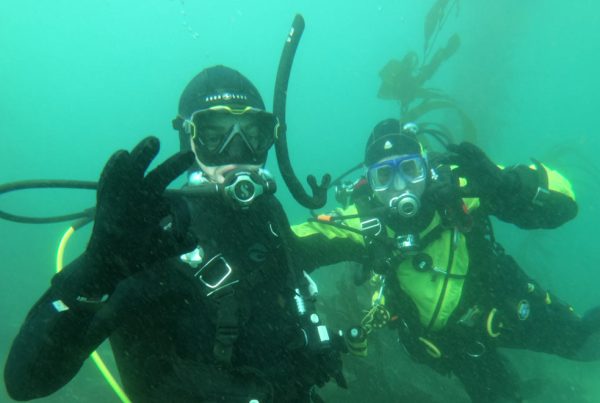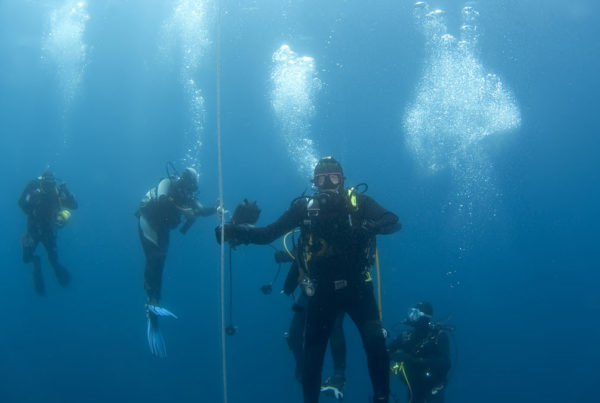Wrecks are great fun to explore. Their history heightens interest and mystique. As artificial reefs, be it intentional or accidental, there is no comparison. They hold abundant surface areas and many angles and a lot of holes in which marine life love to hide.
Can you visit wrecks as an average diver without any special training? Of course! But for maximum enjoyment and safety, you should take a wreck diving specialty course. Wrecks are often deep as well, and you have to be prepared and trained to deal with the complexities of diving in deeper waters.
If a wreck is within the depths of your training, you can visit the site with some basic knowledge. An understanding of the special environment of a sunken shipwreck will make your dive more enjoyable and safer.
SHARP RUSTY METAL
Steel corrodes underwater in such a way that anything with a point—a bolt, rod, or steel cable—becomes razor sharp. Metal edges can also become quite sharp. Worse yet, this sharp metal is hard to see because they are covered in corrosion and marine life. It is, at minimum, rough on a wetsuit or dry suit. Worse, they puncture and lacerate skin, making for wounds that infect easily and heal slowly.
Prevention: keep your actual physical contact with the wreck to aminimum. Watch what you grab and be aware of where all parts of your body are at all times. Even if you just brush up against a steel wreck, corrosion will rub off and can be difficult to get out of neoprene. Serious wreck divers wear overalls over their suits to protect their investments.
PENETRATION? — NO!
Penetrating inside a wreck can seem harmless, especially when you are just going to poke your head into an intentionally prepared and sunk ship. There are several hazards to penetrating a wreck. I will cover just the main ones here.
Surge, Currents and Suction: At an entry way to a wreck with multiple entry and exit points, suction into the wreck can be strong, magnified and confusing. The wreck of the Yukon off San Diego is a classic example. It is a fun and easy wreck for the intermediate diver to explore, but when there is a swell running, the suction near some of the passages is intense. Stick your head in and your entire body can follow rapidly.
Disorientation: Wrecks are rarely straight up and down. Couple that with dark complex passages and the possibility for low visibility from any number of factors and you have a serious problem of not being able to find your way out. Remember, this is an overhead environment. There is no quick escape route to the surface should something go wrong.
Entanglement: Wrecks are not only popular with divers but fishers as well. Fishing nets, line and hooks are common. But more common is wire, cable, and other unforeseen factors inside the wreck. All can snag you.
Collapse: Collapse is a serious issue that is rarely discussed. Areas that may seem stable are only being held together with rust and marine life. Poke your head into a cavity on an older wreck and your bubbles may be just enough to send the roof crashing down.
LIGHTS, CAMERA, ACTION!
Bring a light. Even in bright sun mid-day with great visibility a wreck with have dark corners that deserve exploration with a good dive light. And a little one is not adequate. Bring a big light!
Bring a camera. Wrecks have such great angles and complex and odd forms that it is easy to get good, fun shots. Get low and shoot up with a diver in the picture for scale.
Have a plan of action for your dive. Diving a wreck, more than any other diving available to the average sport diver, requires a plan. Yes, for safety but also for enjoyment. Large wrecks cannot be fully explored on one dive. Decide ahead of on which area you want to concentrate. Also, decide on your path of exploration—bow to stern and back, top to bottom and back, etc. With most wreck dives, you will be using a descent/ascent line, sometimes a mooring line, other times an anchor line, that goes directly to the wreck. Relatively speaking, most wrecks are a small area on the bottom and you usually cannot just free descend and expect to land on it. Rather, use the “down line” point of attachment to the wreck as a base to start and end your dive. It is also a good place for your safety stop.
HISTORY
I am not a big history buff, but with wrecks your diving will be more fun if you know a bit about where you are going to be diving. It will put your dive site in proper perspective of people that struggled, sometimes suffered and even died on the ship you will be diving. Ghosts of the past seem to speak louder underwater.
If you are even mildly interested in diving several wrecks, a specialty course is a must. Finally, hook up with the dive club that prides itself in being the experts on wreck diving in California—the California Wreck Divers (www.cawreckdivers.org). Then you’ll be ready for some serious exploration!










